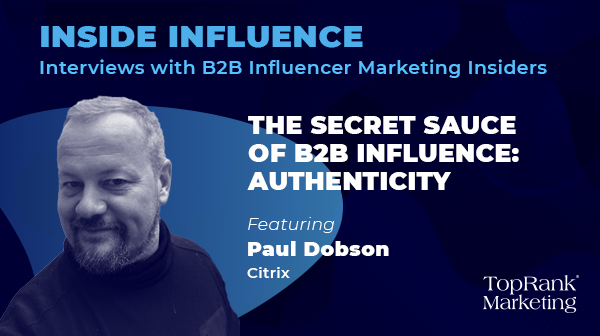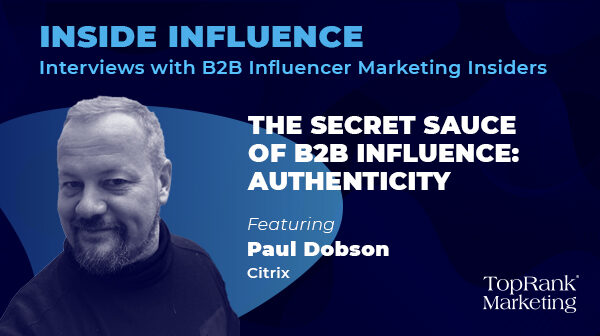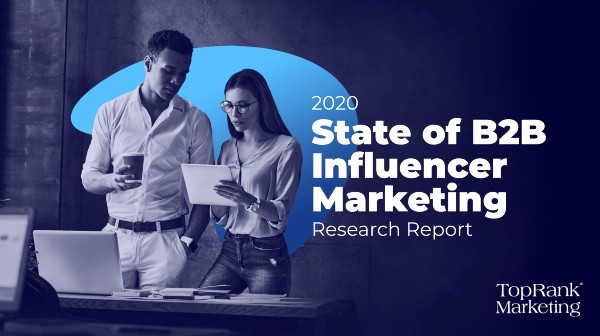
As with most marketing, there is no silver bullet to B2B influencer marketing but there are some essential best practices and strategies that have been proven time and time again. To uncover that secret sauce of working with B2B influencers, Episode 12 of the Inside Influence Show features Paul Dobson, Senior Director, Social and Influencer Marketing at Citrix.
In addition to a few highlights from the 2020 State of B2B Influencer Marketing report, we discussed Paul’s experience working with influencers at Citrix as well as:
- Where influencer marketing fits in the mix at Citrix
- Tips on being great at influencer marketing for a B2B technology brand
- Influencer Marketing vs. Influencer Relations
- The impact of influencer marketing on customer experience
- Advice on starting an influencer marketing program at a B2B brand
- How to get executive buy-in to an influencer marketing program
- How to decide which influencers to work with
- Examples of influencer engagement
- Opportunities to grow influence with B2B brand executives
- How agencies can be most helpful to B2B brands with influencer marketing
- Predictions of influencer marketing in 2021
Check out the full interview podcast here:
See the full video interview of Inside Influence Episode 12 with Paul Dobson here:
Below is a highlight transcription of our discussion.
Tell us about your role at Citrix and where influencer marketing fits?
Paul: I’ve been on quite a journey through Citrix. I started off in the PR side of things. So, to some extent I’ve always been working with with influencers. The media, then went into analyst relations, so the Gartners and Forresters of the world and now social and influencer influencer marketing as well. I really enjoy this aspect of my role and, you know, sitting in corporate communications means getting good exposure to a range of influencers that have gotten me here in my career. Being head of social media means that I also have a lot closer ties to the marketing organization and how we execute that. So it’s really the best of both worlds as far as I’m concerned.
Influencer marketing is an interesting split sometimes between PR and comms or marketing. You seem to be in a sweet spot.
Paul: Absolutely. So it’s kind of interesting the way that we’re approaching marketing, et cetera now is we’re really evolving it somewhat. The barriers between the teams are starting to break down a little bit more effectively. We’re really forming pods and tiger teams around certain campaigns and projects. It helps to be able to understand what’s going on elsewhere and it is a real sweet spot because obviously the influence has come from many pools, not just a traditional B2B influencers.
In the 2020 State of B2B Influencer Marketing Report, you were named as one of the top 20 influencer marketing professionals. What does it take to be at the top of your game when it comes to B2B marketing? With influencer marketing?
Paul: It’s an interesting question because I think as far as influencers are concerned, everything has to come back to the corporate strategy and what you’re trying to achieve with what you’re doing with influencers. Everything has to go back to that when you’re designing your program. For us, it was reaching out and attracting new audiences.
I’ll talk about HR as one audience which is not a typical audience for an enterprise B2B technology company. We wanted to showcase our technology in a very different way that correlated with market trends around something called employee experience. And that’s very important when we’re all sitting at home and working and still trying to do our jobs.
Part of the benefit of working with influencers is that they have a different lens on what’s happening in the world and what’s happening with your company.
So, think about what the corporate goals are and then try and work out what you want the influencers to be able to do. For us, it was social amplification to a certain degree, reaching their audiences with content that we’re working on together, presenting at events when events still existed and potentially may exist again in the future, and then content generation as well.
Part of the benefit of working with influencers is that they have a different lens on what’s happening in the world and what’s happening with your company. You’re giving a different perspective to your audience as well as, as their audiences. That’s how we, in a nutshell, started off with the program and then developed and grown from there.
What are you most excited about when it comes to working with influencers?
Paul: It still is super exciting. I mean, I’ve been working with influencers now for over 20 years, so it’s most definitely something that gets me out of bed in the morning.
To the point we were talking about earlier on, your personal career is your own. It shapes how you think and how you react in certain situations. And as a marketer you end up responding, probably subconsciously, to a situation based on those experiences that you’ve had.
The best influencer campaigns come from the sparring that goes on between what they think and what you think.
But collaborating with influencers to me means that you’re able to temper that to a certain degree and the best influencer campaigns, in my view, come from the sparring that goes on between what they think and what you think. And then it kind of comes out to be something in the middle. It helps you grow as a person in your career.
What I love most about working with influencers is the kind of range of “aha” moments that you have as you go along. And you work with them to form and build campaigns. Because the plans that you start off with, they kind of wiggle a bit. But you get there in the end and they change ever so slightly based on the interactions that you have with your influencers.
What’s your preference: influencer marketing or influencer relations?
Paul: Most definitely, I would say influence relations. You have to build the relationship with your team of influencers in order to do effective influencer marketing.
Influencer marketing is a subset of influencer relations because without the relationship, it just becomes a series of tactical campaigns.
Influencer marketing is a subset of influencer relations because without the relationship, it just becomes a series of tactical campaigns involving somebody else, other than people in your organization. Being able to build out and bring relationships with influencers means it can go anywhere and you can come up with things that you possibly wouldn’t even thought about before.
You talked about the value of relationships and our research study showed that 12 times more marketers cited themselves as being very successful with their influencer marketing that ran always on programs, relationship-driven programs versus those that were doing intermittent campaigns. So there’s ROI in those relationships.
Paul: I also think that when you build a degree of familiarity for your audience with the influencers that you’re working with, there’s a certain comfort that they get from recognizing the people that you work with and the information and the insights that you bring. We’re starting in 2021 to incorporate our influencers, not only in the awareness elements, but also further down the funnel as well to make sure that people see them as their journey goes on.
Our research discovered that 77% of B2B marketers say that their prospective customers rely on advice from industry experts and 74% agree that influencer marketing improves customer and prospect experience with the brand. Do you find this kind of optimism with Citrix?
Paul: I would definitely agree with that. There have been a couple of instances where our influencer program has helped us resonate more with certain audiences that we’re trying to connect with. It’s reduced the amount of time that would take to strike a chord with a certain audience and build appeal with those audiences that we don’t necessarily have a natural affinity with.
It [Influencer Marketing] has reduced the amount of time that would take to strike a chord with a certain audience and build appeal with those audiences that we don’t necessarily have a natural affinity with.
I don’t have the statistics in hand, but our brand tracker shows that with a specific audience, we had a much higher unaided recognition in 2020 than we did in 2019. So, it’s a great way of building our brand with new and existing audiences. As we become more of a use case focused organization versus pushing product, getting out those use cases and having them explained with a slightly different lens with that third party voice is very valuable to give that viewpoint to our customers.
It’s proving to be very important. I think the customer events that we had in the Fall, were an example of where we were able to leverage influencers to really give that additional lens to our consumers.
Based on your experience with influencer marketing at Citrix what advice can you share for other B2B marketers who are thinking of starting their own program?
Paul: So, interesting question. When we started off our formal influencer program above and beyond what we were doing with the press and with the analysts, what we were thinking about is what we were trying to achieve and what our corporate and marketing goals were going to be. For us it was about reaching out to new audiences, showcasing our technology in a way that really correlated with the trends in the market, and educating senior level executives. Traditionally, our technology was seen as a very enterprise and kind of in the guts of the organization. We wanted to make sure that they were aware of the benefits of the technology that they, in some cases, had already bought.
That’s one thing that really shaped the content aspects of what we were trying to do. Then we wanted to think about when it came to the engagement with the influencer team. We had three things in mind, which was presenting at events virtual or otherwise, creating content and social amplification.
When it comes to the execution, think about what it is that you want your influencers to do, Maybe something experiential as where you’re going from your organization. Those were the three pillars that we started off with.
Don’t build a team of like 20 influencers because if you’re trying to build a relationship with 20 people all in one go it’s, it’s not going to be the easiest thing to do.
I think also it’s important to not go out too hard with influencers. Don’t build a team of like 20 influencers because if you’re trying to build a relationship with 20 people all in one go it’s, it’s not going to be the easiest thing to do.
We started off with a program of five to get them off the ground and get really strong results and demonstrate the results that we could build the program on and ask for more funding. Then we wanted to hone in on the areas that we felt were most appropriate for us.
The strongest relationships come from the interplay between your in-house team of influencer relations managers and the team of influencers that you build for the benefit of your organization.
The final piece of advice I would give as you get up and running is not to be too prescriptive. I think we talked about some of this before our discussion, the strongest relationships come from the interplay between your in-house team of influencer relations managers and the team of influencers that you build for the benefit of your organization.
So, there’s gotta be something in it for the the influencers as well. They need to build their business and their brand as much as you need to build your business and your brand. Otherwise, I think you end up with cookie cutter, corporate marketing campaigns and activities that are presented through the lens of the influencer. I don’t see the value in necessarily using them as a direct corporate mouthpiece. The value comes from the breadth and variety of opinions and views.
To connect with Paul, you can find him on Twitter and LinkedIn.
Be sure to check out our previous Inside Influence B2B Influencer Marketing show interviews:
- Episode 1: Rani Mani, Adobe – The Value of B2B Influencer Marketing
- Episode 2: Garnor Morantes, LinkedIn – The Power of Always-On Influence
- Episode 3: Ursula Ringham, SAP – Behind the Scenes with Influencer Marketing Operations
- Episode 4: Janine Wegner, Dell Technologies – Thought Leadership and B2B Influence
- Episode 5: Jen Hotlvluwer, Spirion – Award Winning B2B Influencer Marketing
- Episode 6: Amisha Gandhi, SAP – The Power of Mutual Value for Influencer Marketing
- Episode 7: Pierre-Loïc Assayag, Traackr – Maximizing Marketing ROI with Influencer Technology
- Episode 8: Srijana Angdembey, Oracle – How Influence Creates Better B2B Customer Experiences
- Episode 9: Brian Solis, Salesforce – How B2B Influence Adds Value to Business Customers
- Episode 10: Ryan Bares, IBM Systems – Growing Influence Inside B2B Brands with Employees
- Episode 11: Marshall Kirkpatrick, Sprinklr – Elevating B2B Content with Influencers
To better understand what hundreds of the top B2B marketers are doing to succeed at influencer marketing, including case studies featuring SAP, LinkedIn, Monday.com and Cherwell Software, be sure to check out the 2020 State of B2B Influencer Marketing Research Report:




